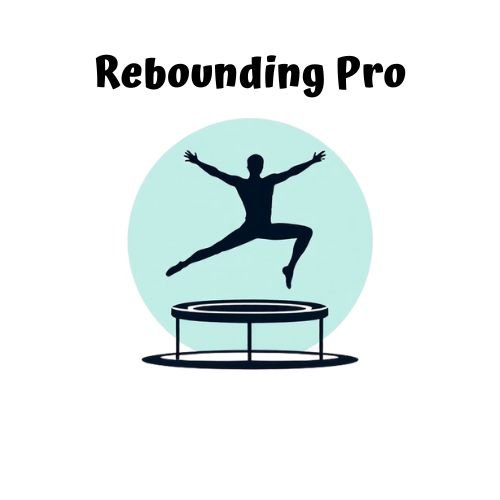To calculate calories burned jumping, multiply your MET value (3.5-12.3 depending on intensity) by your weight in kg, multiply by 3.5, then divide by 200. For example, a 150-pound person rebounding at MET 6.0 for 30 minutes burns about 204 calories. Your weight, jumping intensity, and duration all greatly impact your results. Tracking your sessions consistently and combining jumping with circuit training can maximize your calorie-burning potential.
The Science Behind Trampoline Calorie Burning

While many people view trampoline jumping as merely a fun recreational activity, it’s actually a powerful calorie-burning exercise with scientific backing.
The physics of bouncing creates a perfect storm for energy expenditure, with MET values ranging from 3.5 to 8.0 depending on your jumping intensity.
You can burn between 200-400 calories per hour on a trampoline, making it comparable to traditional cardio exercises like running or cycling.
What makes trampoline exercise particularly effective for weight loss is its full-body engagement—you’re simultaneously working multiple muscle groups while improving coordination and balance.
Just 30 minutes of bouncing provides significant cardiovascular benefits, increasing your heart rate and metabolism.
This elevated calorie burn continues even after you’ve finished your session, contributing to your overall weight loss goals.
Understanding Metabolic Equivalent of Task (MET) for Rebounding
Looking at how effectively a trampoline burns calories requires understanding a key fitness concept: the Metabolic Equivalent of Task (MET). This scientific measurement quantifies the energy expended during rebounding compared to resting state, with one MET equaling approximately 3.5 ml/kg/min of oxygen consumption.
Rebounding typically yields MET values between 4.0 and 8.0, depending on your intensity level.
To calculate your calories burned, use this formula: calories burned = time (minutes) × (MET × 3.5 × weight in kg) / 200.
For perspective, if you weigh 150 pounds (68 kg) and rebound at a moderate intensity (MET 6.0) for 30 minutes, you’ll burn about 204 calories.
This makes rebounding comparable to running or jumping rope for efficient calorie burning.
How Weight Affects Your Trampoline Workout Results

Your body weight greatly impacts the effectiveness of trampoline workouts, creating substantial differences in calorie burn between individuals. The heavier you are, the more calories you’ll burn during your rebounding sessions—a 200-pound person can burn about 563 calories in a 30-minute moderate-intensity session, while someone weighing 150 pounds burns approximately 422 calories.
| Weight (lbs) | Calories Burned (30 min) | Jumping Intensity | Impact Factor |
|---|---|---|---|
| 150 | 422 | Moderate | Lower |
| 180 | 507 | Moderate | Medium |
| 200 | 563 | Moderate | Higher |
| 180 | 176 | 120+ jumps/min | Highest |
Remember that jumping intensity greatly affects your results. You can maximize calories burned by increasing both your workout duration and jumping rate, regardless of your body weight.
Calculating Your Personal Calorie Burn Rate
Your unique physical characteristics greatly impact how many calories you’ll burn during jump rope exercises.
To calculate your personal burn rate, use the formula: calories burned = (MET × your weight in kg × 3.5) ÷ 200, with MET values ranging from 8.8 to 12.3 depending on your jumping intensity.
Tracking both your jumping rate (skips per minute) and session duration will give you the most accurate assessment of your total calorie expenditure.
Personal Factors Affect Burn
When calculating how many calories you burn during jump rope exercises, several personal factors greatly influence your results. Understanding these variables helps you track your fitness progress more accurately and set realistic goals.
Your unique profile affects calorie expenditure in four key ways:
- Body weight – Heavier individuals burn more calories; a 200-pound person can burn approximately 563 calories in a 30-minute session.
- Jumping rate – Higher speeds (120-160 skips per minute) considerably increase calories burned compared to moderate paces (100-120 skips).
- Workout duration – Longer sessions naturally burn more calories, with 30 minutes typically burning 315-580 calories.
- Fitness level – As your body adapts to jump rope exercise, your efficiency changes, potentially affecting your MET value (8.8-12.3).
Track these factors consistently to optimize your jump rope routine for maximum calorie burn.
Rate Calculation Formula
Although many fitness trackers offer automated calorie estimates, calculating your precise jump rope calorie burn gives you more accurate fitness tracking. The formula is straightforward: calories burned per minute = (MET × body weight in kg × 3.5) ÷ 200.
Your body weight considerably impacts your calorie expenditure—heavier individuals burn more calories during the same activity. The MET values for jump rope typically range from 8.8 (moderate jumping) to 12.3 (vigorous jumping), reflecting exercise intensity.
For example, if you weigh 180 pounds (82 kg) and jump at a moderate intensity (MET 11.8), you’ll burn approximately 754 calories per hour.
To maximize accuracy, track your actual jumping duration and maintain a consistent pace throughout your session.
Comparing Trampoline Exercise to Traditional Cardio

While many fitness enthusiasts default to running or cycling for their cardio workouts, trampoline exercise stands as a compelling alternative with comparable benefits.
You’ll burn 300-400 calories per hour on a trampoline if you weigh 150 pounds—similar to the energy cost of traditional cardio workouts.
Consider these key comparisons:
- Trampoline jumping has a MET value of 5.0-8.0, approaching the 7.0-12.0 range of running.
- Both activities engage multiple muscle groups, but trampolining adds balance and coordination benefits.
- Trampoline workouts provide cardiovascular improvements equal to running or cycling.
- You’ll experience less joint stress during trampoline exercise compared to high-impact cardio.
If you’re looking for effective cardio with added fun, trampolining delivers comparable benefits with less physical strain.
Rebounding Intensity Levels and Their Impact on Weight Loss
Tracking your rebound intensity can dramatically affect your weight loss results, with advanced rebounders burning up to 176 calories at 120+ skips/minute compared to beginners at lower rates.
Your body’s metabolic response increases proportionally with jump frequency, creating a more efficient calorie-burning workout when you push your limits.
You’ll maximize your weight loss potential by gradually increasing your rebounding intensity from beginner levels (under 100 skips/minute) to advanced patterns that achieve MET values between 8.8-12.3.
Beginner Vs Advanced Rebounds
When it comes to rebounding exercise, your experience level greatly impacts the calories you’ll burn during your workout. As a beginner, you’ll typically burn 300-400 calories per hour at rates under 100 skips per minute, while advanced participants can torch 600-800 calories hourly by exceeding 120 skips per minute.
Your progression from beginner to advanced status affects your results in several ways:
- Intensity level – Advanced rebounders achieve higher MET values (11.8) through faster jumping.
- Duration capability – Experienced jumpers can sustain 80-minute sessions, burning up to 1,000 calories.
- Technique variety – Advanced participants incorporate high knees and double jumps for enhanced calorie burn.
- Efficiency improvement – Your body becomes more effective at higher-intensity work as you progress.
The dramatic difference between beginner and advanced rebounding demonstrates why consistent practice pays off for weight loss goals.
Tracking Metabolic Intensity
Understanding the precise metabolic impact of your rebounding exercises can transform your weight loss results.
The intensity of your jump rope sessions directly influences calories burned—increasing your pace from 100 to 120 skips per minute can boost calorie expenditure by 10-15%.
Jump rope exercises have impressive metabolic equivalent (MET) values ranging from 8.8 to 12.3 based on intensity.
At vigorous levels (120-160 skips/minute), jumping rope compares to running at 7 mph, burning approximately 11.8 METs.
This efficiency is remarkable: a 200-pound person can torch around 563 calories in just 30 minutes at 100-120 skips per minute.
Optimal Trampoline Workout Duration for Maximum Calorie Burn
Fitness enthusiasts seeking maximum calorie burn on a trampoline should focus on ideal workout duration to achieve their goals. The time you spend bouncing directly impacts your results, with most effective sessions balancing intensity and sustainability.
For peak calorie burn on your trampoline workout, consider these duration guidelines:
- 30-minute sessions – The minimum effective duration for sustained elevated heart rates and meaningful calories burned.
- 20-minute high-intensity intervals – Comparable to a 30-minute moderate run for calorie expenditure.
- 60-minute workouts – Maximum calorie burn potential, especially when incorporating intervals.
- Variable-length sessions – Consistently changing jumping techniques and adding tricks increases intensity, enhancing calorie burn regardless of duration.
Adjust your workout length based on your fitness level and available time for best results.
Tracking Your Progress: Tools and Techniques
To maximize the benefits of your jump exercise routine, accurately tracking your progress becomes essential for long-term success. Start by utilizing a jump rope calorie calculator that factors in your weight, jumping rate, and session duration to determine calories burned during workouts.
Maintain a consistent jumping pace between 100-120 skips per minute to establish reliable baseline measurements. This consistency makes tracking progress more meaningful over time.
Consistent jumping tempo creates measurable benchmarks that reveal your true fitness improvements over weeks and months.
Record workout durations meticulously, as even small increases contribute greatly to overall calorie expenditure. Keep a detailed workout journal documenting your jumping sessions, including total skips, intensity levels, and calories burned.
Regular weight monitoring is equally important since your body weight directly impacts energy expenditure. These tracking techniques provide actionable insights that help you adjust your routine and set realistic, achievable fitness goals.
Setting Realistic Weight Loss Goals With Trampoline Exercise
Setting realistic weight loss goals for your trampoline exercise routine starts with understanding its calorie-burning potential. A 30-minute jumping session can help you burn 200-300 calories, making it an efficient addition to your weight loss journey.
To achieve sustainable results with trampoline workouts:
- Aim for a daily calorie deficit of 500-1000 calories, which supports a healthy weight loss pace of 1-2 pounds weekly.
- Schedule 3-5 trampoline sessions weekly for consistent calories burned and improved fitness levels.
- Recognize that trampoline exercise offers METs of 5.0-8.0, increasing your overall calorie expenditure compared to low-impact activities.
- Track your progress by monitoring both weight changes and improved endurance during your jump sessions.
The Role of Consistency in Trampoline Fitness Results
Consistency serves as the foundation for achieving meaningful results with trampoline fitness. When you commit to at least three weekly sessions, you’ll burn an impressive 400-600 calories per hour—comparable to other intense physical activities like calories burned jumping rope.
For ideal benefits, incorporate 30-minute trampoline sessions several times weekly. This consistent approach enhances cardiovascular health and aerobic capacity while simultaneously improving muscle tone throughout your body.
Like the benefits of jumping rope, trampoline workouts strengthen multiple muscle groups, including your core, legs, and arms.
You’ll notice improved coordination and balance within just a few weeks of regular practice. By maintaining your routine, you’re not only maximizing weight loss potential but also building endurance that translates to better performance in all your physical activities.
Combining Rebounding With Other Exercises for Enhanced Results
Combining your rebounding routine with circuit training can amplify your calorie burn by up to 30% when you incorporate strength moves like squats and lunges between bouncing intervals.
You’ll maximize fat-burning potential by implementing HIIT rebounding combos, alternating 30 seconds of intense jumping with 15 seconds of recovery for up to 400 calories burned in just 30 minutes.
Adding resistance bands or light weights to your bounce sessions creates a strength-plus-bounce approach that engages multiple muscle groups simultaneously, potentially increasing your energy expenditure by 50% compared to standard rebounding.
Circuit Training Integration
While traditional rebounding workouts offer significant calorie-burning benefits on their own, incorporating them into circuit training can dramatically amplify your results.
The high MET value of rebounding (8.8-12.3) makes it an ideal cardiovascular component in any circuit, maximizing calories burned throughout your session.
A well-structured rebounding circuit can help you:
- Burn 300-500 calories in just 30 minutes by alternating between 10-minute rebounding intervals and strength exercises
- Customize intensity levels to match your fitness capacity while maintaining continuous energy expenditure
- Improve multiple fitness components simultaneously – cardiovascular endurance, coordination, and strength
- Create varied workouts that prevent plateaus and keep your body consistently burning calories
You’ll find that circuit training with rebounding offers exceptional versatility, allowing you to design workouts that challenge your entire body while maximizing caloric output.
HIIT Rebounding Combos
Supercharge your calorie burn by integrating high-intensity interval training (HIIT) with your rebounding routine. This powerful combination can torch up to 30% more calories than traditional cardio, with a typical 30-minute session burning between 300-600 calories depending on your weight and intensity level.
For maximum energy expenditure, alternate between high-intensity rebounding intervals (reaching MET values of 8.0-12.0) and strength exercises like squats or push-ups. This keeps your metabolic rate elevated while engaging multiple muscle groups simultaneously.
Take your workout to the next level by incorporating core exercises such as planks or mountain climbers during rest periods. This strategic pairing not only intensifies your session but also promotes overall fitness while maximizing your time.
You’ll achieve extensive results in shorter workouts—perfect for busy schedules and efficient fat burning.
Strength Plus Bounce
Elevate your workout efficiency by pairing rebounding with strength exercises for a powerful fitness combination. This strategic pairing maximizes calories burned while developing multiple fitness components simultaneously. A 10-minute rebounding session alone burns approximately 150 calories, but when combined with resistance training, your energy expenditure soars.
- Integrate resistance bands during bounce sessions to increase muscle engagement and strength development.
- Add bodyweight exercises like squats between jumping intervals to improve coordination while maintaining elevated heart rate.
- Incorporate weighted movements on the rebounder to boost caloric burn—a 200-pound person can torch 563 calories in just 30 minutes.
- Alternate between rebounding and strength stations to create a thorough circuit that targets cardiovascular fitness and muscle endurance.
These Physical Activities work synergistically, delivering superior results in less time than traditional workouts.
Nutritional Considerations for Trampoline Weight Loss Programs
Successful trampoline exercise programs require more than just jumping sessions to maximize weight loss results.
To optimize calories burned during your trampoline workouts, pair your exercise with proper nutrition. Consume a balanced diet rich in whole foods including lean proteins, fruits, and vegetables to fuel your body efficiently.
Before jumping, eat a small pre-workout snack such as a banana or yogurt to sustain energy throughout your session. This simple step helps you maintain intensity longer, increasing your overall weight loss potential.
Stay hydrated before, during, and after your trampoline workout to support performance and recovery.
Post-exercise, incorporate protein-rich foods to aid muscle repair and maintain your metabolism.
Consider tracking your caloric intake alongside your exercise to create a thorough approach that aligns with your weight loss goals.
Common Mistakes That Limit Calorie Burning on Trampolines
While proper nutrition powers your trampoline weight loss journey, your jumping technique directly impacts results.
You’ll burn fewer calories if you’re making these common mistakes:
- Using low-intensity bouncing instead of higher intensity jumps considerably reduces calories burned during each session.
- Poor posture leads to inefficient movements that waste energy without maximizing calorie expenditure.
- Jumping for less than 10 minutes doesn’t allow your body enough time to reach peak calorie-burning potential.
- Neglecting to engage your core and other muscle groups transforms what could be a full-body workout into a much less effective exercise.
To maximize calories burned, incorporate variety with tuck jumps and double-unders while maintaining proper form throughout longer sessions.
Your body will thank you with improved results.
Creating a Personalized Rebounding Weight Loss Plan
Creating an effective rebounding weight loss plan starts with understanding your personal metrics and exercise capacity. Your body weight considerably affects calories burned during rebounding—heavier individuals naturally burn more while performing the same jumps.
Your weight determines your rebounding calorie burn—know your metrics before jumping into this effective weight loss strategy.
Develop a structured routine that varies jumping intensity. At moderate rates (100-120 skips per minute), you’ll burn between 315-580 calories in a 30-minute session, depending on your weight.
Even short 10-minute sessions can effectively burn approximately 150 calories. For best results, alternate between high-intensity intervals (120-160 skips per minute) and moderate jumping rates.
Track your progress using a calorie burn calculator where you can input your weight, intensity level, and exercise duration. This data helps you adjust your plan as needed while keeping you motivated toward your weight loss goals.
Frequently Asked Questions
How Many Calories Do Jumps Exercise Burn?
You’ll burn 315-580 calories in 30 minutes of jumping rope, depending on your weight and intensity. A 200-pound person jumping at 100-120 skips per minute burns around 563 calories in this timeframe.
How Many Calories Burn if I Jump?
Your calorie burn while jumping depends on your weight and intensity. You’ll burn roughly 11-19 calories per minute jumping rope, so a 15-minute session could burn 165-285 calories for most people.
How to Calculate Calories Burned From Jump Rope?
To calculate jump rope calories burned, multiply your MET value (8.8-12.3) by your weight in kg and 3.5, then divide by 200. You’ll burn more calories at higher intensities and longer durations.
How Many Calories Does 30 Minutes of Jump?
You’ll burn 315-420 calories from 30 minutes of jumping rope if you weigh 150 pounds. If you’re heavier, your burn increases—378-504 calories at 180 pounds and 420-580 calories at 200 pounds.
In Summary
You’ve now got all the tools to calculate your own calorie burn during jumping exercises. Remember, your weight, intensity, and duration all impact your results. Don’t forget to track your progress, mix up your routine, and pair your rebounding with proper nutrition. Whether you’re jumping for fitness or fun, you’re making a great choice for effective, low-impact cardio that delivers impressive calorie-burning benefits.





Leave a Reply